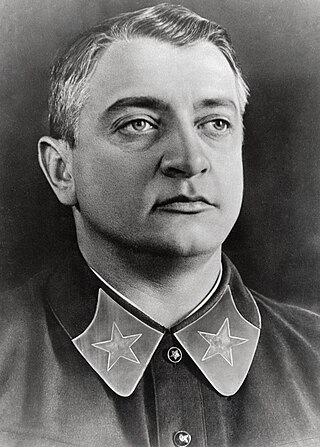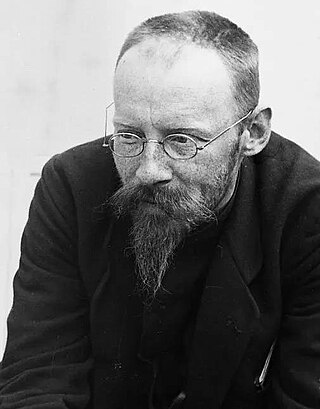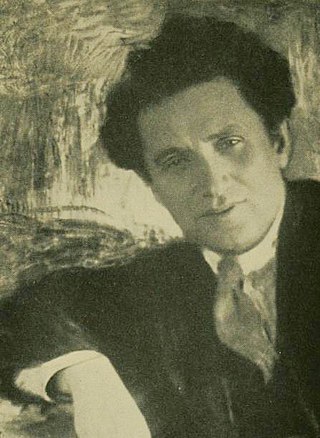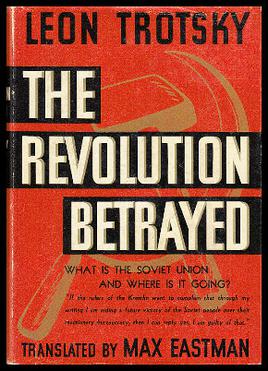Related Research Articles

Lev Davidovich Bronstein, better known as Leon Trotsky, was a Russian revolutionary, Soviet politician, and political theorist. He was a central figure in the 1905 Revolution, October Revolution, Russian Civil War, and establishment of the Soviet Union. Trotsky and Vladimir Lenin were widely considered one of the two most prominent Soviet figures and was de facto second-in-command during the early years of the Russian Soviet Republic. Ideologically a Marxist and a Leninist, his thought and writings inspired a school of Marxism known as Trotskyism.

The October Revolution, also known as the Great October Socialist Revolution, October coup, Bolshevik coup, or Bolshevik revolution, was a revolution in Russia led by the Bolshevik Party of Vladimir Lenin that was a key moment in the larger Russian Revolution of 1917–1923. It was the second revolutionary change of government in Russia in 1917. It took place through an armed insurrection in Petrograd on 7 November 1917 [O.S. 25 October]. It was the precipitating event of the Russian Civil War. The initial stage of the October Revolution which involved the assault on Petrograd occurred largely without any human casualties.

Trotskyism is the political ideology and branch of Marxism developed by Russian revolutionary and intellectual Leon Trotsky along with some other members of the Left Opposition and the Fourth International. Trotsky described himself as an orthodox Marxist, a revolutionary Marxist, and a Bolshevik–Leninist as well as a follower of Karl Marx, Frederick Engels, Vladimir Lenin, Karl Liebknecht, and Rosa Luxemburg. His relations with Lenin have been a source of intense historical debate. However, on balance, scholarly opinion among a range of prominent historians and political scientists such as E.H. Carr, Isaac Deutscher, Moshe Lewin, Ronald Suny, Richard B. Day and W. Bruce Lincoln was that Lenin’s desired “heir” would have been a collective responsibility in which Trotsky was placed in "an important role and within which Stalin would be dramatically demoted ".
The ten years 1917–1927 saw a radical transformation of the Russian Empire into a socialist state, the Soviet Union. Soviet Russia covers 1917–1922 and Soviet Union covers the years 1922 to 1991. After the Russian Civil War (1917–1923), the Bolsheviks took control. They were dedicated to a version of Marxism developed by Vladimir Lenin. It promised the workers would rise, destroy capitalism, and create a socialist society under the leadership of the Communist Party of the Soviet Union. The awkward problem, regarding Marxist revolutionary theory, was the small proletariat, in an overwhelmingly peasant society with limited industry and a very small middle class. Following the February Revolution in 1917 that deposed Nicholas II of Russia, a short-lived provisional government gave way to Bolsheviks in the October Revolution. The Bolshevik Party was renamed the Russian Communist Party (RCP).

Mikhail Nikolayevich Tukhachevsky, nicknamed the Red Napoleon, was a Soviet general who was prominent between 1918 and 1937 as a military officer and theoretician. He was later executed during the Moscow trials of 1936–1938.

Semyon Mikhailovich Budyonny was a Soviet cavalryman, military commander during the Russian Civil War, Polish-Soviet War and World War II, and politician, who was a close political ally of Soviet leader Joseph Stalin.
The history of the Communist Party of the Soviet Union was generally perceived as covering that of the Bolshevik faction of the Russian Social Democratic Labour Party from which it evolved. In 1912, the party formally split, and the predecessor to the Communist Party of the Soviet Union became a distinct entity. Its history since then can roughly be divided into the following periods:

Iona Emmanuilovich Yakir was a Red Army commander and one of the world's major military reformers between World War I and World War II. He was an early and major military victim of the Great Purge, alongside Mikhail Tukhachevsky.

Vladimir Alexandrovich Antonov-Ovseenko, real surname Ovseenko, party aliases 'Bayonet' (Штык) and 'Nikita' (Никита), literary pseudonym A. Galsky, was a prominent Bolshevik leader, Soviet statesman, military commander, and diplomat.

Andrei Sergeyevich Bubnov was a Russian Bolshevik revolutionary leader, one of Bolshevik leaders in Ukraine, Soviet politician and military leader and member of the Left Opposition.

Ivar Tenisovich Smilga was a Latvian Bolshevik leader, Soviet politician and economist. He was a member of the Left Opposition in the Soviet Union.

Georgy (Yury) Leonidovich Pyatakov was a Ukrainian revolutionary and Bolshevik leader, and a key Soviet politician during and after the 1917 Russian Revolution. Pyatakov was considered by contemporaries to be one of the early communist state's best economic administrators, but with poor political judgement.
Joseph Stalin was the General Secretary of the Communist Party of the Soviet Union's Central Committee from 1922 until his death in 1953. In the years following Lenin's death in 1924, he rose to become the leader of the Soviet Union.

Joseph Stalin started his career as a robber, gangster as well as an influential member and eventually the leader of the Bolshevik faction of the Russian Social Democratic Labour Party. He served as the General Secretary of the Central Committee of the Communist Party of the Soviet Union from April 3, 1922 until the official abolition of the office during the 19th Party Congress in October 1952 and supreme leader of the USSR from January 1924 until his death on March 5, 1953.

Yemelyan Mikhailovich Yaroslavsky was a Bolshevik revolutionary, Communist Party functionary, journalist and historian.

Grigory Yevseyevich Zinoviev was a Russian revolutionary and Soviet politician. A prominent Old Bolshevik, Zinoviev was Vladimir Lenin's closest associate prior to 1917 and a leading government figure in the early Soviet Union, serving as chairman of the Communist International (Comintern) from 1919 to 1926.
The Moscow trials were a series of show trials held by the Soviet Union between 1936 and 1938 at the instigation of Joseph Stalin. They were nominally directed against "Trotskyists" and members of the "Right Opposition" of the Communist Party of the Soviet Union.
- The "Case of the Trotskyite–Zinovievite Terrorist Center" ;
- The "Case of the Anti-Soviet Trotskyist Center" ; and
- The "Case of the Anti-Soviet 'Bloc of Rightists and Trotskyites'".

The Kronstadt rebellion was a 1921 insurrection of Soviet sailors, naval infantry, and civilians against the Bolshevik government in the Russian port city of Kronstadt. Located on Kotlin Island in the Gulf of Finland, Kronstadt defended the former capital city, Petrograd, as the base of the Baltic Fleet. For sixteen days in March 1921, rebels in Kronstadt's naval fortress rose in opposition to the Soviet government they had helped to consolidate. Led by Stepan Petrichenko, it was the last major revolt against Bolshevik rule on Russian territory during the Russian Civil War.

The Revolution Betrayed: What is the Soviet Union and Where is it Going? is a book published in 1936 by the exiled Soviet leader Leon Trotsky. This work analyzed and criticized the course of historical development in the Soviet Union following the death of Vladimir Lenin in 1924 and is regarded as Trotsky's primary work dealing with the nature of Stalinism. The book was written by Trotsky during his exile in Norway and was originally translated into Spanish by Victor Serge. The most widely available English translation is by Max Eastman.
In Trotskyist political theory, a degenerated workers' state is a dictatorship of the proletariat in which the working class' democratic control over the state has given way to control by a bureaucratic clique. The term was developed by Leon Trotsky in The Revolution Betrayed and in other works.
References
- 1 2 Greene, Douglas (2023). Stalinism and the Dialectics of Saturn. New York City: Lexington Books. p. 210.
- 1 2 3 Bergman, Jay (2019). The French Revolutionary Tradition in Russian and Soviet Politics, Political Thought, and Culture. Oxford: Oxford University Press. pp. 406–414.
- ↑ Sakmyster, Thomas (2005). "A Hungarian in the Comintern: József Pogány/John Pepper". In Morgan, Kevin; Cohen, Gidon; Flinn, Andrew (eds.). Agents of the Revolution: New Biographical Approaches to the History of International Communism in the Age of Lenin and Stalin. Bern: Peter Lang. p. 59.
- ↑ Whitney, Richard Merrill (1924). Reds in America. New York City: The Beckwith Press. p. 44.
- 1 2 Shlapentokh, Dimtry V. (1991). "Thermidor or Mongol Empire: History as political model in Russian émigré thought". Cahiers du Monde Russe. 32 (3): 379–408. doi:10.3406/cmr.1991.2288.
- ↑ Spilberg, Percy (October 1969). The Image of Leon Trotsky in British and American Opinion 1917-1928. McGill University. p. 25.
- ↑ Greene, Douglas (2023). Stalinism and the Dialectics of Saturn. New York City: Lexington Books. pp. 223–224.
- ↑ Lockwood, David (2013). "Rival Napoleons? Stalinism and Bonapartism". War & Society. 20 (2): 61.
- ↑ Aleksandrovich Medvedev, Roy (1989). Let History Judge. Translated by Shriver, George. New York: Columbia University Press. p. 536.
- ↑ Kotkin, Stephen (2017). Stalin: Waiting for Hitler, 1929-1941 . New York: Penguin. p. 31. ISBN 978-1-59420-380-0.
- ↑ Dhooge, Ben (2017). "Civic Poetry in Russian Prague". Russian Literature. 87 (89): 183.
- ↑ Whitewood, Peter (2015). "Subversion in the Red Army and the Military Purge of 1937–1938" (PDF). Europe-Asia Studies. 67 (1): 5. doi:10.1080/09668136.2014.990708 . Retrieved 17 April 2024.
- ↑ Crean, Jeffrey (2024). The Fear of Chinese Power: an International History. New Approaches to International History series. London, UK: Bloomsbury Academic. p. 61. ISBN 978-1-350-23394-2.
- ↑ Rudolph, Jack W. (1938). "Thunder in the East". Journal of the United States Artillery. 81 (1): 273.
- ↑ Zhukov, Georgi K. (1969). Marshal Zhukov's Greatest Battles. New York: Harper and Row. p. 16.
- ↑ "Russia's Zhukov: The Man in the News". US News & World Report. Vol. 43, no. 1. 1957. p. 42.
- ↑ AFP (4 October 2013). "Vietnam's 'Red Napoleon' Vo Nguyen Giap dies aged 102". The Telegraph. ISSN 0307-1235 . Retrieved 16 July 2018.